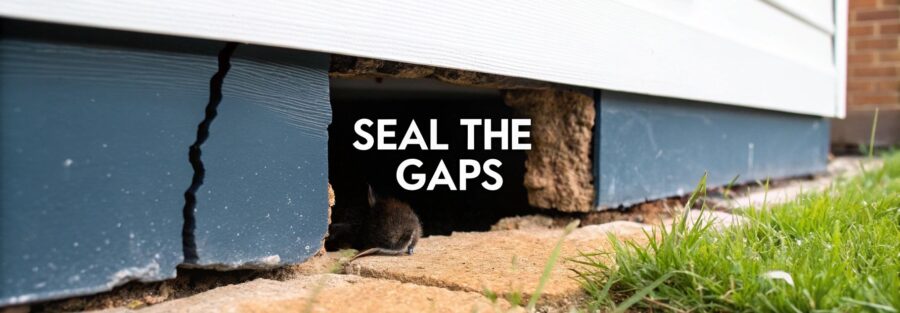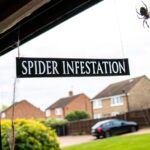It's a frustrating but all-too-common discovery. You see a flash of movement out of the corner of your eye, or you find those tell-tale droppings in the back of a cupboard. The first question everyone asks is: how on earth did it get in?
The truth is, mice don’t need an open door or a gaping hole. They’re masters of infiltration, squeezing through gaps so small you’d probably never even notice them. Any opening the size of a 5p coin is a potential welcome mat. Their survival instincts are powerful drivers, pushing them to seek out warmth, shelter, and a reliable food source – and your home is the perfect five-star hotel.
Your Home Through a Mouse’s Eyes
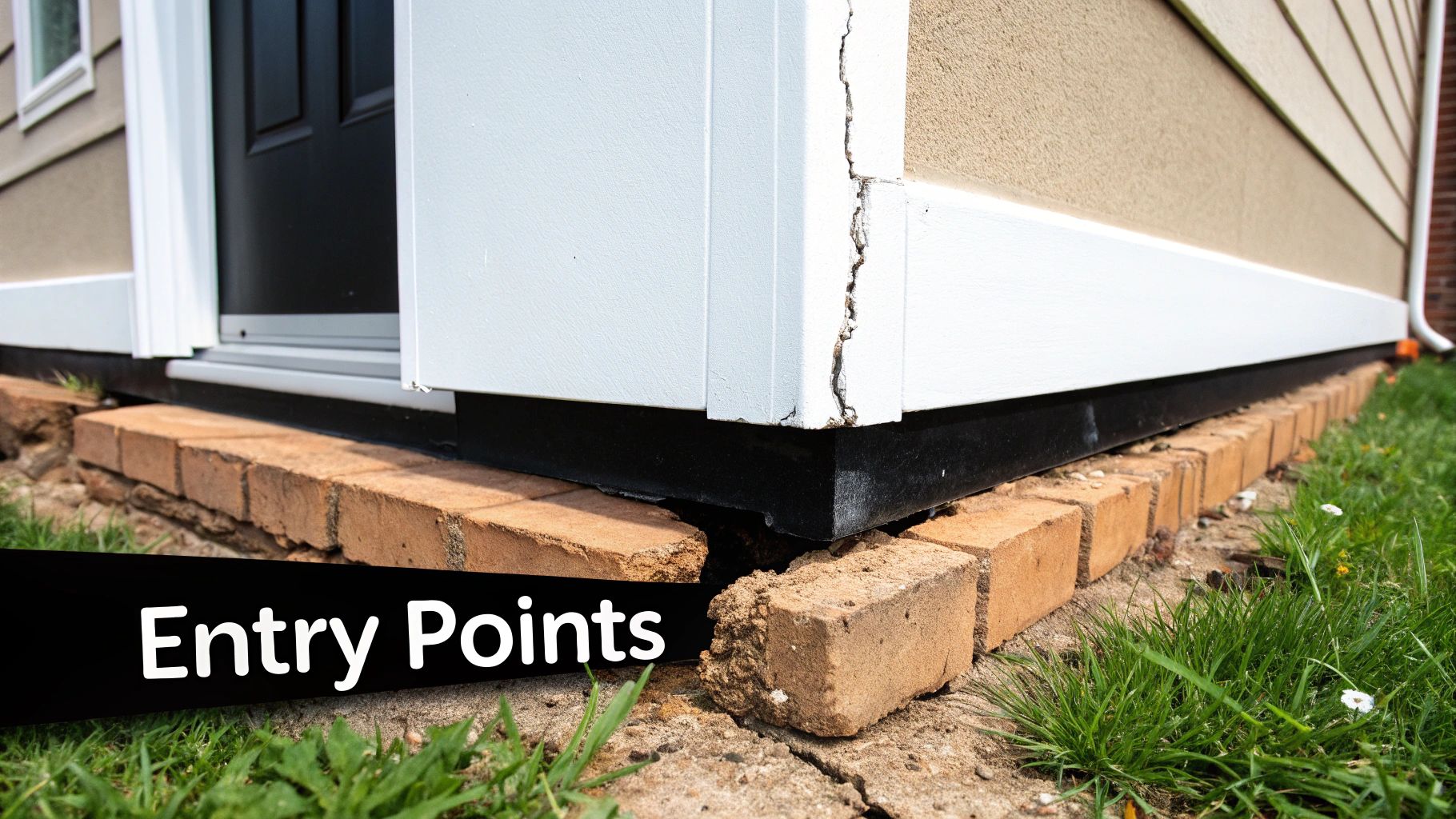
Imagine your home is a fortress. To you, the walls are solid. To a mouse, those same walls are a network of potential secret passages. They aren’t just wandering in by accident; they're actively probing for weaknesses.
Their primary mission is survival, and your house provides everything they need, especially when the weather turns cold or their natural food sources start to disappear. Understanding this mindset is the first, crucial step toward effective pest-proofing.
This isn't a random act. It's a calculated move driven by opportunity and a powerful instinct to find a safe harbour. When things get tough outside, the pressure for them to find a way inside your home skyrockets.
How Outside Events Can Drive Mice Indoors
Sometimes, a mouse problem has little to do with your home and everything to do with what's happening in the wider environment. Major changes can suddenly force rodent populations to seek out new territories.
A perfect, if unfortunate, example was the COVID-19 lockdown. With restaurants, pubs, and city centres deserted, the rodents that relied on their waste suddenly lost their primary food supply. And where did they go? Straight to residential areas.
The data from that period is startling. UK homes experienced a massive 120% surge in rodent-related pest control call-outs between March and June 2020 compared to the year before. You can read the full breakdown of how lockdown drove rodents into our homes in Aviva's news release.
This really hammers home a key point: an infestation isn't always a sign of an unclean house. Often, it’s simply a consequence of external pressures. To properly figure out "how do mice get into your house," we have to look at both the how and the why.
"A mouse doesn't see a house; it sees a fortress of warmth and a larder full of food. Every small gap is a potential key to the castle."
To give you a head start, here’s a quick guide to some of the most common ways mice will try to breach your defences.
Quick Guide to Common Mouse Entry Points
This table summarises the top weak spots mice exploit, what they’re looking for, and what you can do right away.
| Entry Point | Why Mice Use It | Quick Prevention Tip |
|---|---|---|
| Gaps around Pipes | Openings for plumbing and wiring offer easy, sheltered access points directly into walls. | Seal gaps with steel wool and a flexible sealant. |
| Foundation Cracks | Even tiny cracks in the foundation or brickwork are an open invitation. | Inspect and repair any cracks with cement or appropriate filler. |
| Vents and Air Bricks | Uncovered vents are like open highways leading straight into your property. | Cover all external vents with fine, sturdy wire mesh. |
| Gaps Under Doors | A surprising number of mice get in through worn or missing door sweeps. | Install a brush strip or rubber seal along the bottom of external doors. |
| Loft and Eaves | Mice are excellent climbers and will exploit gaps in the roofline or eaves. | Check for and repair any damaged roof tiles or gaps where the roof meets the wall. |
By thinking like a mouse, you can start to see your home from a different perspective and spot these vulnerabilities before they do. This guide will help you build that foundational knowledge, turning you from a victim into a proactive defender of your home.
Thinking Like a Mouse: Their Biology and Behaviour
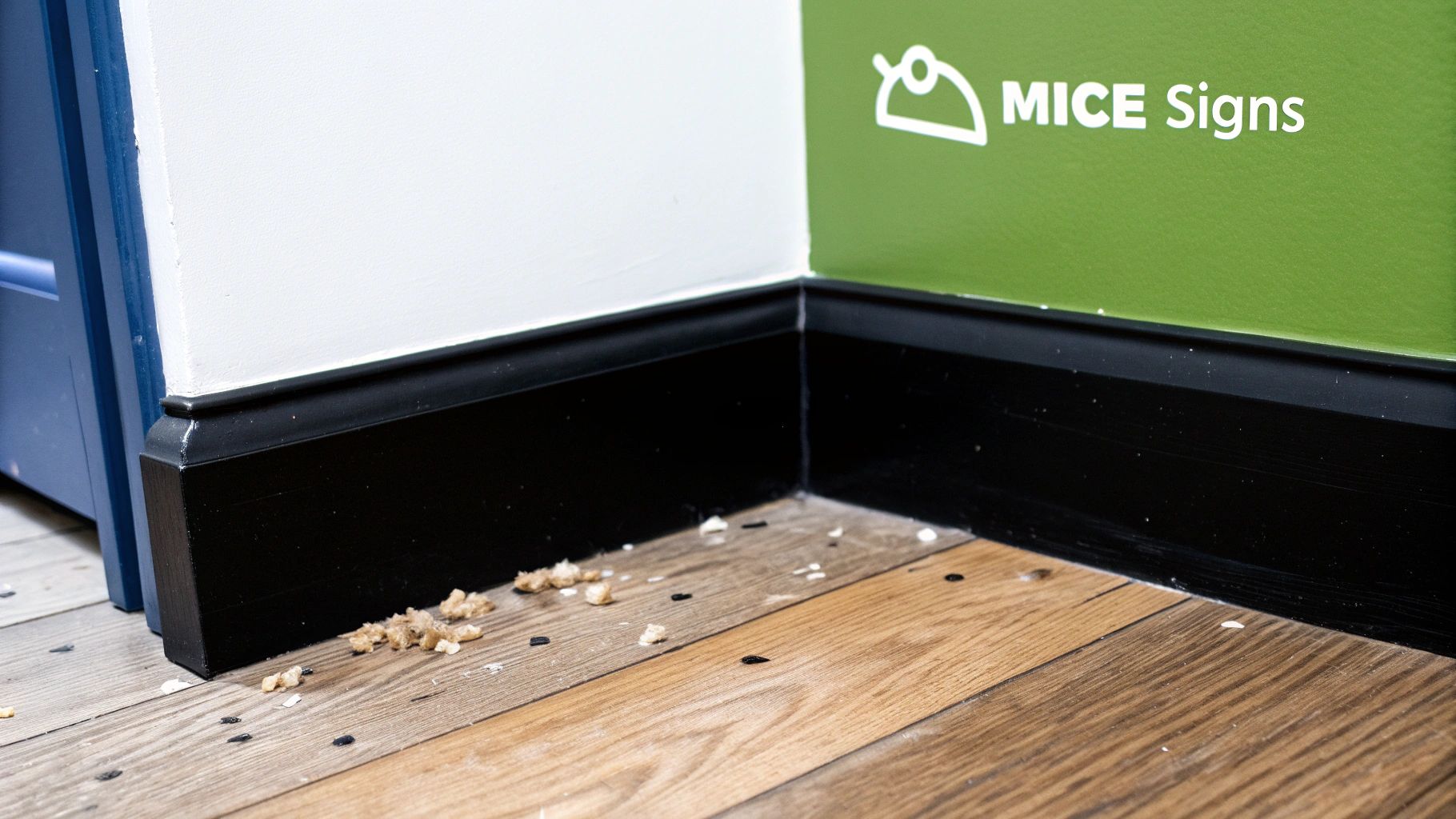
To really stop mice getting into your house, you have to understand the biological toolkit that makes them such relentless and successful intruders. It’s not just about looking for holes; it’s about appreciating the incredible adaptations that allow them to survive and thrive. Their whole existence is built around exploiting the smallest of opportunities.
Think of a mouse not as a solid object, but as something almost liquid. They have a remarkably flexible, collapsible skeleton. That’s no exaggeration—it's a biological marvel that lets them flatten their bodies and elongate their rib cages to squeeze through openings that seem impossibly small.
If a mouse can get its head through a gap, the rest of its body will almost certainly follow. That’s why a hole the diameter of a 5p coin or a standard pencil is a wide-open door for them.
Masters of Stealth and Senses
Beyond their physical agility, mice are equipped with powerful senses that guide their every move. They're primarily nocturnal, which is why an infestation can grow substantially before you even spot a single one. Under the cover of darkness, they're free to explore, map out your home, and establish pathways to food sources without being disturbed.
Their sense of smell is particularly sharp. It acts like a highly sensitive GPS, guiding them towards the faintest scent of food from a surprising distance. A few crumbs on the floor or an unsecured bag of pet food in the pantry is like a bright, flashing beacon to a nearby mouse.
A mouse’s world is a map of scents and textures. They follow trails of odour you can't detect and use their whiskers to navigate along walls in near-total darkness, creating 'mouse motorways' throughout your home.
This reliance on scent and touch explains why you so often find droppings or smear marks along skirting boards. These are their established, trusted routes through your territory.
Key Biological Traits That Help Mice Invade
Understanding these core behaviours is crucial for predicting their movements and blocking their paths effectively. Their instincts are finely tuned for infiltration and survival.
-
Incessant Gnawing: A mouse's incisor teeth never stop growing. This biological imperative forces them to constantly gnaw on materials—not just for food, but to file down their teeth. This is why they can easily chew through wood, plastic, and even soft electrical wiring to create or enlarge an entry point.
-
Exceptional Agility: Mice are phenomenal climbers. Rough surfaces like brickwork, pebbledash, or ivy-covered walls are as easy for them to scale as a ladder. This vertical mobility means you can't just focus on ground-level gaps; they can access your home through the roofline, attic vents, or gaps around upstairs windows.
By appreciating these biological advantages, you can move from simply reacting to a problem to proactively outsmarting your unwelcome guests. You now have a much clearer idea of how mice leverage their unique biology to get into your house.
Finding Your Home's Weak Spots
Every house, no matter how new or well-built, has potential weak spots that a determined mouse can exploit. To get a handle on how mice are getting into your house, you need to put on your detective hat and conduct a thorough inspection of your own property. It's all about searching for clues and spotting the subtle entry points that often go completely unnoticed.
This means doing a ground-up tour of your home's exterior and interior. Start right at the bottom and work your way up, examining every crack, gap, and opening with a critical eye. Remember what you're looking for: any space the size of a 5p coin. That's all they need.
The Foundation and Ground-Level Entry
The foundation is your home's first line of defence, but it’s also where many vulnerabilities lie. Houses settle over time, and small cracks can easily appear in brickwork, mortar, or concrete. To a mouse, these are a welcome mat.
Pay very close attention to where utility services enter your home. Those small, often untidy gaps left around gas pipes, water lines, and television cables are notorious entry points. A contractor drilling a hole for a new wire might leave just enough of a gap for a mouse to squeeze through later on.
It's a common misconception that rodent problems are a "big city" issue. The truth is, they're a nationwide headache. Between 2023 and mid-2025, UK councils dealt with over half a million rat infestations, which shows just how widespread these pests have become.
Another critical area to check is your air bricks. They are essential for ventilation, but their standard design often has holes large enough for a young mouse to slip right through. Leaving them unprotected is like leaving a side door unlocked. Thankfully, effective solutions like professional-grade mesh air brick covers are available to block pests without getting in the way of airflow.
Walls and Higher Access Points
Don't make the mistake of only looking at ground level. Mice are fantastic climbers and can scale rough surfaces like brick, pebbledash, or even dense ivy with ease. This climbing ability gives them access to a whole new range of potential entry points higher up on your house.
Inspect these areas carefully:
- Boiler Flues: The point where a boiler flue exits the wall is often poorly sealed.
- Window and Door Frames: Look for gaps between the frame and the surrounding brickwork.
- Weep Holes: These small gaps in brickwork are designed to let moisture drain, but they can also let mice in.
The image below breaks down the key actions for a solid prevention strategy, and it all starts with sealing these very gaps.
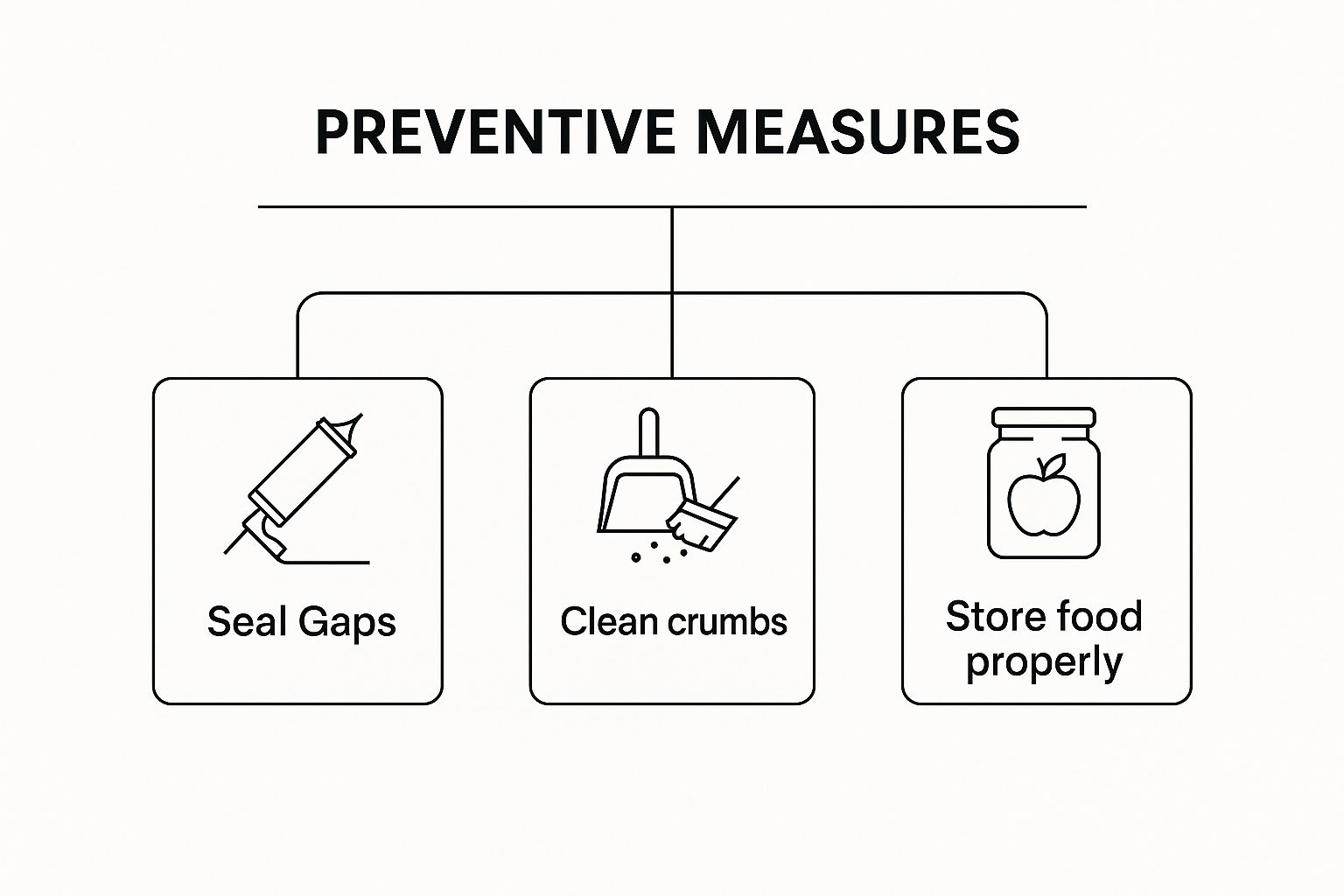
As you can see, creating physical barriers ('Seal Gaps') is the foundational step, which is then supported by getting rid of things that attract them, like food sources.
Up to The Roofline
Finally, your inspection needs to take you all the way up to the roof. This is an area people frequently overlook, yet it offers countless hidden entrances for an agile mouse. Gaps in the eaves, where the roof meets the walls, are a prime target.
Check for any damaged or displaced roof tiles, as these can create surprisingly large openings. You should also examine the soffits and fascia boards for any rot or damage that mice could easily chew through to gain access to your loft. Once they're in your loft, they have a safe, sheltered place to nest and can travel down into the rest of the house through wall cavities. No inspection is complete without checking these high-level weak spots.
Removing the Welcome Mat for Mice
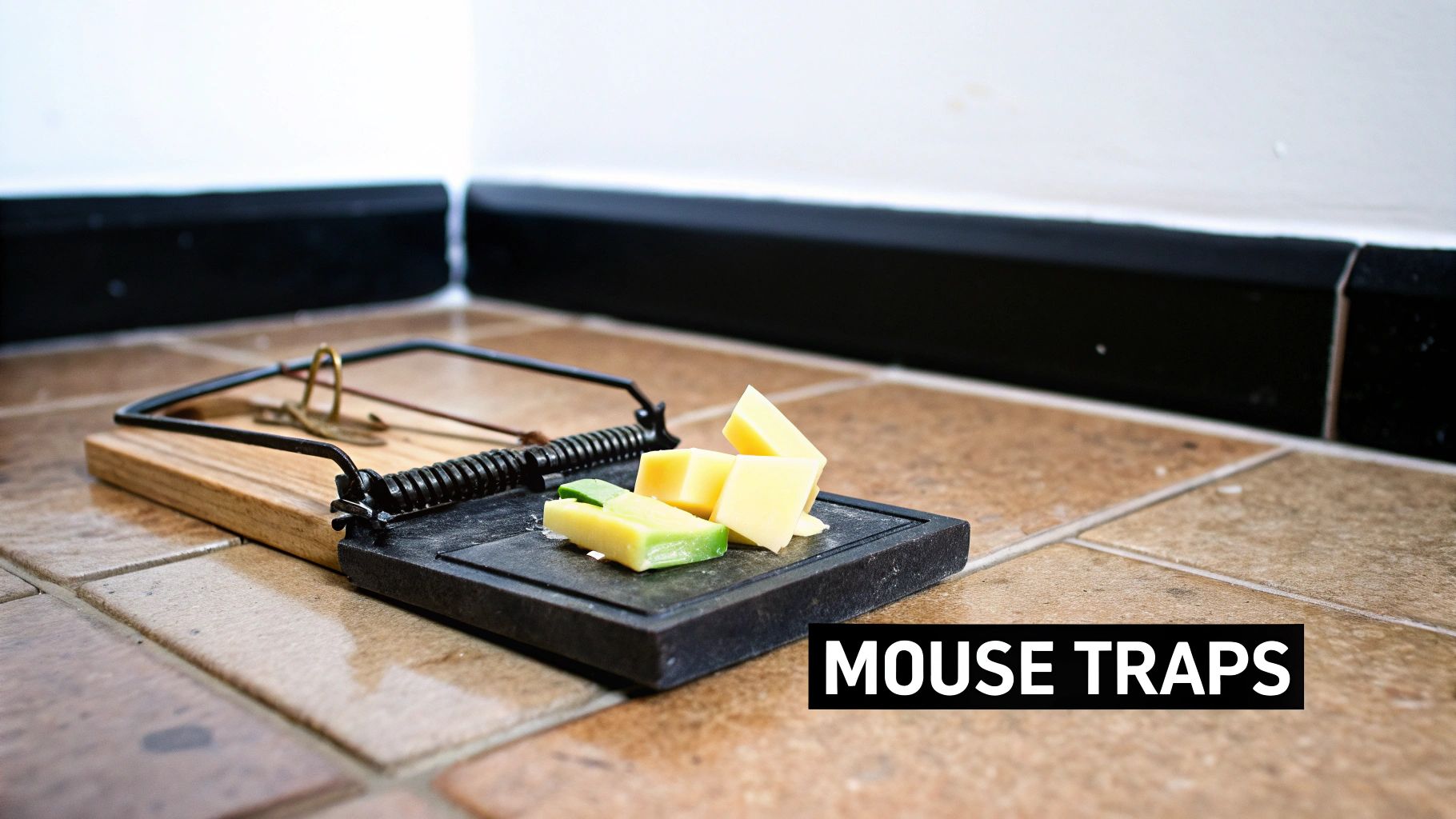
Sealing up cracks and holes is a huge first step, but it’s only half the battle. To really get a handle on how mice get into your house, you also need to look at what’s attracting them in the first place. You might be rolling out the welcome mat without even knowing it.
Think of it this way: if your garden offers a five-star experience, mice will check in and immediately start looking for an upgrade to the main building—your home. This means going beyond just wiping up crumbs in the kitchen and learning to see your property through the eyes of a rodent.
At its core, a mouse is driven by three simple needs: food, water, and shelter. An untidy garden, an easy-to-access bin, or even a forgotten bowl of pet food provides at least one of these, instantly making your home a prime target.
When you start removing these temptations, you take away their reason for sticking around. It’s all about making your property look like a barren landscape from their perspective, encouraging them to move on to somewhere more inviting.
Removing Outdoor Food Buffets
The most powerful magnet for any pest is a reliable food source. You might be meticulous about keeping your kitchen spotless, but the real feast often lies just outside your door. With their excellent sense of smell, mice can sniff out these easy meals from a surprising distance.
Common culprits that create an all-you-can-eat rodent buffet include:
- Bird Feeders: While you’re trying to help the robins, fallen seeds create a high-energy, ground-level feast for mice. Try using "no-mess" seed mixes or fitting a catch tray underneath.
- Unsecured Bins: Bins without tight-fitting lids are an open invitation. Mice can easily climb or gnaw their way into bin bags, guaranteeing themselves a nightly feed.
- Pet Food: Leaving bowls of dog or cat food out overnight, especially near the back door, is like setting a dinner table specifically for mice.
- Compost Bins: Open or badly maintained compost heaps are a major draw. Make sure your compost bin is securely sealed and try to avoid adding cooked food scraps.
Take away these food sources, and you send a clear message: the restaurant is closed. This alone can dramatically reduce your property’s appeal.
Eliminating Shelter and Nesting Spots
Once mice have found food, their next job is to find somewhere safe and sheltered to hide from predators and the weather. These outdoor hideouts act as their staging grounds—a basecamp from which they can plan their raid on your home.
Take a look around your garden. Is there an overgrown patch of weeds? Dense shrubs growing right up against the house? What about that pile of fallen leaves you’ve been meaning to clear? Each one provides perfect cover. The same goes for stacks of firewood, garden debris, or old furniture left leaning against the house; these are all five-star nesting sites.
By keeping your garden tidy, trimming back plants from your walls, and storing firewood away from the building, you get rid of these vital hiding spots. This forces them out into the open, making your property a much riskier and less attractive place to set up home. If you still find signs of an active infestation despite your best efforts, professional pest control services can help identify and safely remove nests that are already established.
Your Practical Guide to Mouse Proofing
Alright, now you know how to spot your home’s weak points and understand what draws mice in. It’s time to get hands-on and turn that knowledge into a rock-solid defence.
Fortifying your home against these persistent little intruders isn’t just about plugging a few obvious holes. It’s about choosing the right materials and using them correctly to create a barrier they simply can’t get through. The goal is to make it impossible for a mouse to find a way in, giving you the peace of mind that comes from a truly mouse-proofed home. This isn’t a temporary fix; it’s a long-term solution.
Choosing Your Mouse Proofing Arsenal
When it comes to sealing gaps, you quickly learn that not all materials are created equal. Mice are relentless gnawers, so you need to use substances they either can't or won't chew through. A common mistake is using expanding foam on its own—they’ll tear right through it in minutes.
Here are the best materials for the job:
-
Wire Wool or Copper Mesh: This is your secret weapon. Mice absolutely hate chewing on metal. Pack wire wool or copper mesh tightly into cracks, holes, and gaps around pipes before you seal them. It creates a painful, impenetrable obstacle for their teeth.
-
Durable Sealants and Fillers: Once you've packed a hole with wire wool, use a strong, flexible sealant to finish the job. For bigger cracks in brickwork or foundations, a cement mortar mix is the most durable, permanent solution.
-
Kick Plates and Brush Strips: That little gap under an external door is like a main road for mice. Fitting a metal kick plate or a tough, bristly brush strip closes this gap completely, denying them easy access.
The rodent problem is growing across the UK, making these steps more critical than ever. Recent figures show local authorities responded to 291,132 pest infestation incidents in a single year, with an overwhelming 91% related to rodents. That’s a call for help about once every two minutes, showing just how many homeowners are fighting this battle. You can explore the full findings on the UK's rising rodent problem from Direct Line Group.
Your DIY Inspection and Sealing Checklist
With your materials ready, it's time for a thorough sweep of your property. Use this checklist to guide you, making sure you don’t miss a single potential entry point. Be methodical—check everything, no matter how small it seems.
Key Insight: A successful mouse proofing strategy is proactive, not reactive. Sealing your home before you have a major problem is far easier and more effective than trying to fight an established infestation.
-
Foundation and Ground Level: Walk the entire perimeter of your house. Use a torch to inspect for cracks in the foundation, brickwork, and any crumbling mortar. Seal every single one you find.
-
Utility Entry Points: Look closely where pipes, wires, and cables enter your home. These gaps are prime entryways. Pack them tightly with wire wool, then finish with a good quality sealant.
-
Vents and Air Bricks: Cover all external vents, including air bricks and tumble dryer outlets, with a fine, galvanised wire mesh. Make sure you secure it firmly so it can’t be pushed aside.
-
Doors and Windows: Check the frames of all your doors and windows for gaps or poor seals. Apply new sealant where it’s needed and fit brush strips to the bottom of all external doors.
-
Roofline and Eaves: If you can do it safely, inspect your roofline. Look for gaps under eaves, damaged soffits, or any displaced tiles. This is a common but often-missed area where mice get in from above.
While this guide gives you a strong DIY foundation, some situations really do need a professional touch. For comprehensive solutions and expert advice, you can learn more about our professional rodent control and proofing services.
Got Questions About Mice? We've Got Answers.
Even with the best intentions, a few questions always pop up. When you understand how a mouse thinks and behaves, you're much better equipped to get them out—and keep them out for good.
Here are some of the most common things we get asked about mice in the house.
Can Mice Really Climb Walls?
Yes, absolutely. Mice are astonishingly good climbers. Any rough vertical surface—think brick, pebbledash, stone, or even thick ivy climbing up the side of your house—is like a ladder to them. Their sharp little claws can find a grip on the tiniest imperfections.
This is why just checking around your ground floor isn't enough. They can and will find their way into attic vents, gaps under the eaves where your roof meets the wall, or holes around a first-floor window. Your home's entire exterior is a potential climbing frame.
What Is the Smallest Gap a Mouse Can Squeeze Through?
A young mouse can flatten its body and squeeze through a gap as tiny as 6-7 millimetres across. That's about the width of a standard pencil. It sounds unbelievable, but their skeletons are incredibly flexible, allowing them to contort their bodies in ways that seem to defy physics.
The rule of thumb is simple but absolutely critical: if a mouse can get its head through a gap, the rest of its body is coming through, too. This is why sealing every single crack you find, no matter how small it looks, is non-negotiable for proper mouse proofing.
Never underestimate what they are physically capable of; their survival literally depends on finding and exploiting these tiny weaknesses in our homes.
Will My Cat or Dog Keep Mice Away?
Having a cat or dog around can certainly make your home feel like a riskier place for a mouse, but it’s far from a foolproof security system. For a mouse that's desperate for warmth, food, and shelter—especially in the middle of a cold winter—the potential reward often outweighs the risk.
Besides, not every pet has a strong prey drive. Many are too well-fed, domesticated, or simply not bothered. It's better to think of your pet as one layer of defence, not the whole strategy. Physical barriers, like sealed entry points and excellent sanitation, are always more reliable for preventing mice from getting inside in the first place.
Are Mice a Seasonal Problem?
Yes, you're far more likely to notice an increase in mouse activity during the autumn and winter months. As the weather turns colder and their natural food sources like seeds and insects disappear, your warm, dry house starts looking like a five-star hotel with a fully stocked pantry.
This makes autumn the most critical time of year to check your home's defences and be extra vigilant about cleaning up crumbs. That said, a mouse is an opportunist. An infestation can happen at any time of year if the conditions are right.
Don't let mice make your house their home. For expert, evidence-based solutions that get to the source of the problem, trust Pest Predators Limited. Our tailored rodent control and proofing services will safeguard your property and give you lasting peace of mind. Get your free quote today.

